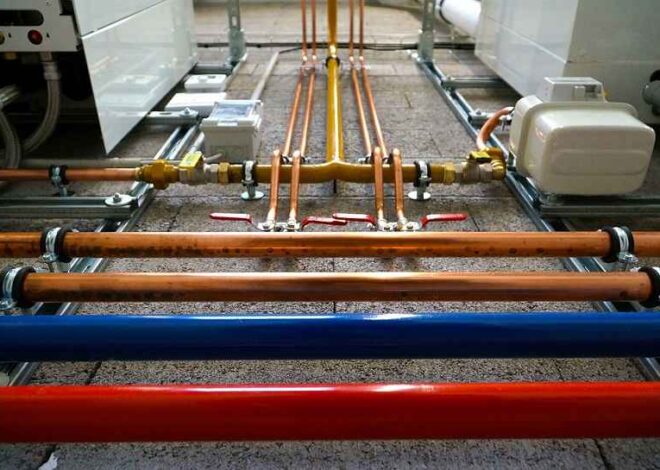
The Ultimate Guide to Regular Plumbing Inspections and Maintenance
Welcome to the world of plumbing—where a small leak can turn into a waterfall, and a minor drip might just spell disaster! Whether you’re a seasoned homeowner or new to the game, understanding the ins and outs of your plumbing system is crucial. Picture this: what if you could prevent costly repairs, save water (and money), and ensure your home runs smoothly with just a little regular attention? Enter our Ultimate Guide to Regular Plumbing Inspections and Maintenance! In this comprehensive post, we’ll dive deep into the importance of routine checks, share expert tips for keeping your pipes in pristine condition, and arm you with knowledge that will empower you as a savvy homeowner. Say goodbye to unexpected emergencies; let’s get started on safeguarding your sanctuary today!
Introduction to the Importance of Regular Plumbing Inspections and Maintenance
Your plumbing system is the unsung hero of your home. It works tirelessly behind the scenes, delivering fresh water and disposing of waste without any fanfare. But just like any other part of your house, it needs regular attention to keep functioning smoothly. Ignoring its maintenance can lead to costly repairs and even damage to your property.
Regular plumbing inspections are not just a luxury; they are essential for maintaining a healthy home environment. Whether it’s a minor leak or rust lurking in the pipes, early detection makes all the difference. In this ultimate guide, we’ll explore why prioritizing plumbing system maintenance should be at the top of every homeowner’s checklist, how you can identify issues before they escalate, and when it’s time to call in the pros versus going DIY. Let’s dive into keeping those pipes flowing freely!
Benefits of Regular Plumbing Inspections and Maintenance
Regular plumbing inspections and maintenance provide peace of mind. Knowing that your plumbing system is in good shape can reduce stress related to unexpected leaks or clogs.
Preventative care saves money. By identifying small issues before they escalate, you avoid costly repairs down the road. A simple fix today could prevent a major disaster tomorrow.
Efficiency is another big advantage. An optimally functioning plumbing system uses less water and energy, which can lead to lower utility bills each month.
Additionally, regular checks help maintain property value. Well-maintained systems are more attractive to potential buyers should you decide to sell in the future.
Finally, keeping up with maintenance improves overall health and safety at home. Regular inspections catch issues that could affect air quality or create hazardous situations within your living space.
Signs That Indicate Your Plumbing System Needs Attention
Your plumbing system can be quite vocal when it needs attention. Pay close attention to any unusual sounds like gurgling or banging. These noises often hint at trapped air or blockages.
If you notice water stains on your walls or ceilings, it’s a sign that leaks may be lurking behind the surface. Ignoring these signs can lead to more extensive damage over time.
Another red flag is a sudden increase in your water bill without an apparent reason. This spike might indicate hidden leaks draining your wallet and resources.
Slow drains are also not just inconvenient; they signal potential build-up in your pipes. If multiple fixtures are affected, the issue could be more serious than simple clogs.
Lastly, unpleasant odors coming from drains should never be ignored as they could indicate stagnant water or decay within the system. Addressing these issues promptly ensures a healthier home environment.
DIY vs Professional Inspections and Maintenance: Pros and Cons
When it comes to plumbing system maintenance, many homeowners weigh the choice between DIY efforts and hiring a professional.
DIY inspections can save you money. They allow you to get hands-on with your plumbing, helping you understand its nuances better. Plus, small tasks like checking for leaks or clearing minor clogs are often manageable without expert help.
However, tackling complex issues alone might lead to bigger problems down the line. Without proper training, it’s easy to overlook critical signs of damage or wear.
On the other hand, professional plumbers bring experience and expertise. They know what to look for during an inspection that an untrained eye might miss.
Yet hiring a pro does come with costs that can add up quickly. Weighing these aspects against each other helps in making informed decisions about your plumbing needs and long-term home care strategy.
Steps for Conducting a DIY Inspection and Basic Maintenance Tasks
Conducting a DIY plumbing inspection can be straightforward. Start with checking for leaks under sinks and around toilets. A small drip can lead to bigger problems down the line.
Next, tackle any clogs in your drains. Use a plunger or a drain snake to keep water flowing smoothly. Regularly clearing your pipes prevents major backups.
Maintaining proper water pressure is essential too. Install a pressure gauge on an outdoor spigot to monitor levels consistently. If you notice fluctuations, it might indicate hidden issues.
Rust or corrosion can signal trouble in older pipes. Inspect visible sections of piping regularly and address any signs of wear promptly.
Don’t forget about your water heater! Flushing it annually helps remove sediment buildup, extending its life and efficiency.
Finally, check the quality of your water periodically—unusual taste or odors may hint at larger concerns needing attention.
-
Checking for Leaks
Checking for leaks is a crucial part of plumbing system maintenance. Even the smallest leak can lead to significant water waste and costly damage over time.
Start by inspecting exposed pipes in your home, especially under sinks and around appliances. Look for any signs of moisture or water stains on surfaces nearby.
Don’t forget about hidden areas too. Check behind walls or underneath flooring if you notice an increase in your water bill without explanation.
You can also perform a simple test using food coloring in your toilet tank. If color seeps into the bowl within 30 minutes, there’s a leak that needs attention.
Regularly checking for leaks not only preserves your plumbing but also protects your wallet from unexpected expenses down the line. Addressing issues promptly ensures peace of mind as you maintain a healthy home environment.
-
Clearing Clogs
Clogs can be a homeowner’s worst nightmare. They often lead to slow drains, unpleasant odors, and even water damage if left untreated. Regular maintenance can help prevent these issues.
To clear clogs effectively, start with the simplest solution: a plunger. It’s surprising how many blockages respond to this handy tool. For more stubborn clogs, consider using a drain snake or auger. These tools reach deep into pipes where most debris hides.
If you prefer natural methods, try pouring baking soda followed by vinegar down your drain. This combo creates a fizzing reaction that dislodges minor blockages without harsh chemicals.
For persistent problems, it might be time to inspect your plumbing system further. Sometimes tree roots or extensive buildup require professional assistance for thorough clearing and prevention strategies in the future.
-
Maintaining Water Pressure
Maintaining proper water pressure is crucial for a functional plumbing system. Low water pressure can indicate underlying issues like leaks or blockages, while excessively high pressure can cause damage to pipes and fixtures.
To check your home’s water pressure, use a simple gauge attachment on an outdoor spigot. Ideally, it should range between 40-60 psi. If you find yourself outside this range, it’s time to investigate further.
Adjusting the pressure regulator can often resolve minor issues. This device helps regulate incoming water from the main supply line to ensure optimal flow in your home.
Regular maintenance is key here too. Clean faucet aerators and showerheads periodically to prevent mineral buildup that may restrict flow. Keeping these components clear ensures consistent performance throughout your plumbing system without unnecessary strain or wear.
-
Addressing Rust or Corrosion
Rust and corrosion can silently wreak havoc on your plumbing system. These issues often arise in older pipes, particularly those made from iron or galvanized steel. When moisture seeps into the metal, oxidation begins, leading to rust formation.
If you notice reddish-brown stains around fixtures or hear unusual sounds when water flows, it’s time to investigate. Ignoring these signs may result in leaks or even pipe failure.
To address this problem, start by inspecting exposed pipes regularly for any visible signs of rust. A wire brush can help remove some surface rust; however, if the damage is extensive, replacement may be necessary.
Consider using protective coatings specifically designed for plumbing materials. These barriers can prevent moisture exposure and slow down the corrosion process significantly. Regular inspections are essential to catch these issues early before they escalate into costly repairs.
-
Flushing Water Heater
Flushing your water heater is an essential part of plumbing system maintenance. Over time, sediment builds up at the bottom of the tank. This buildup can lead to reduced efficiency and even damage.
To flush it out, start by turning off the power or gas supply. Next, attach a garden hose to the drain valve located near the bottom of the tank. Open this valve carefully; hot water will flow out along with any accumulated sediment.
Let it run until you see clear water coming through the hose. This process usually takes about 10-15 minutes. Afterward, close the valve and remove the hose before turning your water heater back on.
Regular flushing helps extend your unit’s lifespan while maintaining optimal performance. It’s a small task that pays big dividends in comfort and savings on energy bills!
-
Checking Water Quality
Checking water quality is essential for maintaining a healthy plumbing system. Contaminated water can lead to serious health issues and damage your pipes. Regular testing helps you catch problems early.
Start by examining the color and clarity of your tap water. If it appears cloudy or has an unusual tint, that’s a red flag. Unpleasant odors can also indicate contamination.
Home test kits are available for measuring levels of chlorine, pH, and other harmful substances. These kits are simple to use and provide immediate results.
Pay attention to any changes in taste as well. A metallic or bitter flavor may suggest corrosion in your pipes.
If you’re unsure about your findings, don’t hesitate to contact professionals who specialize in water quality testing. They have the expertise needed to identify potential threats that might not be visible at first glance.
Hiring a Professional Plumber for Inspections and Maintenance: What to Expect
When hiring a professional plumber, transparency is key. Expect an initial assessment where they’ll evaluate your plumbing system and discuss any concerns you may have.
Costs can vary significantly based on the complexity of the job and local rates. Always ask for a detailed estimate before work begins to avoid surprises.
Look for qualifications that show expertise, such as licensing and insurance. Experience in residential plumbing systems is also valuable.
Professional plumbers typically offer comprehensive services—from inspections to repairs. They will identify issues like leaks, clogs, or water quality problems efficiently.
Additionally, many provide preventive maintenance plans to help keep your plumbing system running smoothly year-round. This proactive approach can save you money in potential repair costs down the line.
-
Cost Factors
When considering plumbing system maintenance, costs can vary widely. Factors such as location play a significant role in pricing. Urban areas may see higher rates due to demand.
The complexity of the issue also affects the cost. A simple leak repair will typically be less expensive than tackling major pipe replacements or extensive renovations.
Materials used during repairs and installations contribute to expenses too. High-quality materials might come with a higher price tag but often provide better longevity.
Time is another factor; more complex jobs require additional labor hours, which can add to your overall bill. Be sure to discuss these aspects upfront with your plumber for clarity on potential costs before any work begins.
-
Qualifications to Look for in a Plumber
When searching for a qualified plumber, look for relevant certifications and licenses. These credentials ensure that the plumber has undergone necessary training and adheres to local regulations.
Experience is another crucial factor. A seasoned plumber has likely encountered various issues and can handle unexpected challenges effectively. Don’t hesitate to ask about their background in residential or commercial plumbing based on your needs.
Check for insurance coverage as well. This protects you from liability if accidents occur during their work. It also indicates professionalism and reliability.
Reading reviews online can provide insights into a plumber’s reputation within the community. Look for feedback regarding punctuality, workmanship, and customer service.
Lastly, effective communication skills are essential in any service industry. A good plumber should be able to explain issues clearly and offer solutions without overwhelming jargon.
-
Services Offered by Professional Plumbers
Professional plumbers offer a wide array of services tailored to maintain your plumbing system effectively. They can tackle complex issues like pipe repairs, replacements, and installations. Whether it’s fixing a leaky faucet or replacing an entire sewer line, their expertise is invaluable.
Drain cleaning is another essential service. Plumbers use advanced tools to clear clogs that DIY methods might not resolve. This ensures your drains flow smoothly without any nasty backups.
Water heater maintenance and repair are also common tasks for professionals. They diagnose problems quickly and recommend the best solutions to keep your hot water flowing when you need it most.
Additionally, many plumbers conduct thorough inspections of your plumbing system. These assessments help identify potential problems early on before they become costly disasters.
With regular service from seasoned professionals, you can enjoy peace of mind knowing that your plumbing needs are in capable hands.
How your plumbing system, regular inspections and maintenance
When it comes to ensuring the longevity and efficiency of your plumbing system, regular inspections and maintenance are essential. Taking proactive steps can save you from costly repairs down the line.
Start by understanding what a routine inspection involves. A professional plumber will assess all elements of your plumbing system, from pipes to fixtures. They’ll look for leaks, potential blockages, and signs of wear that could lead to larger issues.
Cost factors vary widely based on location and service complexity. Generally, basic inspections might be affordable while comprehensive services can command higher fees due to labor intensity or specialized tools required.
Qualifications matter when hiring a plumber. Look for licenses, certifications, and reviews from previous clients to gauge reliability. Experienced professionals offer peace of mind with their expertise in diagnosing problems early on.
Professional plumbers provide a range of services beyond simple inspections — they can handle everything from emergency repairs to installations that improve water efficiency. By investing in these services regularly, you ensure your plumbing remains efficient and trouble-free.
Whether you choose DIY methods or hire a pro depends on your comfort level with home maintenance tasks. There’s no one-size-fits-all approach; it’s about finding what works best for maintaining your home’s plumbing system effectively over time.


